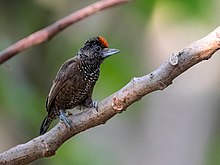Varzea piculet
| Varzea piculet | |
|---|---|

| |
| male | |

| |
| female | |
| Scientific classification | |
| Kingdom: | Animalia |
| Phylum: | Chordata |
| Class: | Aves |
| Order: | Piciformes |
| Family: | Picidae |
| Genus: | Picumnus |
| Species: | P. varzeae
|
| Binomial name | |
| Picumnus varzeae Snethlage, 1912
| |
The varzea piculet (Picumnus varzeae) is a species of bird in the family Picidae, the woodpeckers, piculets, and wrynecks. It is endemic to Brazil's Amazon basin where it occurs in seasonally flooded Várzea forests, which gives the bird its common name. Its natural habitat is tropical moist lowland forest, and as the trees are progressively being cleared in the Amazon basin, the population of the bird is declining, and as a consequence, the International Union for Conservation of Nature has rated it as an "endangered species".
Taxonomy[]
This species was first described in 1912 by the German-Brazilian ornithologist Emilie Snethlage who collected birds in Brazil for two decades.[2] The specific name refers to "várzea", the Brazilian name for the seasonally flooded forested area close to the Amazon River.[3] There are no subspecies. This bird occasionally hybridises with the white-barred piculet (Picumnus cirratus).[4][5]
Description[]
The varzea piculet is a small species, some 8 to 9 cm (3.1 to 3.5 in) in length. The male differs from the female in having variable amounts of red on the fore and mid-crown; this red patch is the result of the crown feathers having broad red tips, and the rest of the crown in males and the whole crown in females is black with white speckles.[4] The upper parts of the body are chocolate-brown, sometimes with an olive tinge, and occasionally slightly barred with black. The tail is deep brown apart from the central pair of feathers, which are whitish, and the two outer pairs of feathers which have a whitish bar near the tip. The underparts are some shade of brown with light barring and streaking in darker brown and white. The iris is brown, the beak is black and the legs and feet are bluish-grey. The juvenile is similar to the female but the underparts are more heavily barred. This piculet is unlikely to be confused with any other piculet because it is the only species in its range with dark underparts.[6]
Distribution and habitat[]
The varzea piculet is endemic to Brazil in tropical South America where it has a rather limited range. It lives along the Amazon River in a wildlife corridor, in the forest called várzea forest, a freshwater swamp forest. It ranges from the confluence of the Amazon River with the Rio Negro in a 275 km (171 mi), variable-width corridor downstream for about 850 km (528 mi) to the confluence of the Trombetas River from the north. The confluence of the Tapajós River joins here from the south. Its typical habitat is dense forest with vines and creepers on the Amazon floodplain and adjoining swampy forested areas, wooded islands and riverine woodland. It is a sedentary and non-migratory species.[6]
Ecology[]
The varzea piculet is presumed to feed on small invertebrates like other members of the genus, but its diet has not been studied. Its breeding habits are also poorly known, but the breeding season may be from June to December, and young birds have been recorded in September.[4]
Status[]
The varzea piculet is a poorly known bird with a restricted range in the Brazilian rainforest. It is threatened by the clearance of the forest for agricultural purposes and by proposed changes in the Brazilian Forest Code which will allow landowners amnesty for illegal fellings and the right to leave narrower strips of forest alongside watercourse. There are also proposals to build dams to provide hydro-electric power in the area which will permanently flood part of its habitat. Suitable habitat for the bird is projected to reduce by 50% or more over the next ten years (three generations). For these reasons, the conservation status of this bird has been assessed by the International Union for Conservation of Nature as being "endangered".[1]
References[]
- ^ a b BirdLife International (2016). "Picumnus varzeae". IUCN Red List of Threatened Species. 2016: e.T22680736A92875297. doi:10.2305/IUCN.UK.2016-3.RLTS.T22680736A92875297.en. Retrieved 12 November 2021.
- ^ Junghans, Miriam (2008). "Emilia Snethlage (1868-1929): Uma naturalista alemã na Amazônia". História, Ciências, Saúde-Manguinhos. 15: 243–255. doi:10.1590/S0104-59702008000500013.
- ^ Jobling, James A. (2010). Helm Dictionary of Scientific Bird Names. Bloomsbury Publishing. p. 399. ISBN 978-1-4081-3326-2.
- ^ a b c Winkler, H.; Christie, D.A.; Sharpe, C.J. "Varzea Piculet (Picumnus varzeae)". Handbook of the Birds of the World Alive. Lynx Edicions, Barcelona. Retrieved 24 April 2017.
- ^ Eugene M. McCarthy (2006). Handbook of Avian Hybrids of the World. Oxford University Press, USA. p. 108. ISBN 978-0-19-518323-8.
- ^ a b Gorman, Gerard (2014). Woodpeckers of the World: A Photographic Guide. Firefly Books. p. 64. ISBN 978-1770853096.
- IUCN Red List endangered species
- Picumnus (bird)
- Birds of the Brazilian Amazon
- Endemic birds of Brazil
- Birds described in 1912
- Taxa named by Emilie Snethlage
